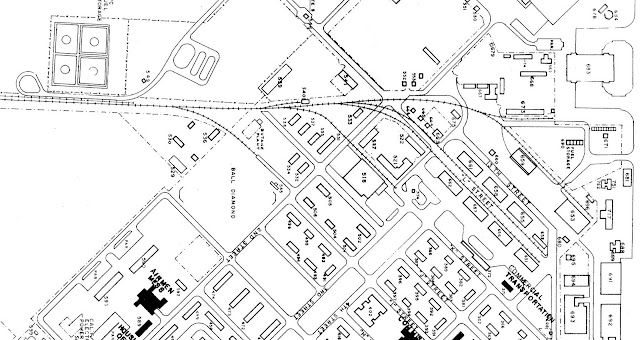This time we'll tour George Air Force Base (Victorville Army Air Field) and then look at some progress in laying my first tracks in staging.
George AFB is the final scenic area of my future layout that we can tour, as the rest of the layout will all be in staging. In fact, George AFB will probably be just a couple of storage tracks in staging, adjacent to the Mojave Northern quarry staging tracks, unless I live long enough to build a model of the air base itself. I was in the Air Force long ago, so I'd love to have an air base on my layout.
Last time we were touring the Lower Narrows and saw that a branch line to the air base departed from the main line there and curved through the Lower Narrows scene and off into staging. In real life, that branch line wound its way up a steep grade to the air base, which was on a plateau northwest of Victorville.
Here's the sign board that was at the gate into the base in later years:
The base was built as an Army base during World War II and was named Victorville Army Air Field. Here is one of its aircraft hangars, with a C-47 inside:
During the war the base published a periodical called "Bombs Away," as seen here:
The Army switcher, which was a GE 45-tonner after the war, would come into Victorvile to turn on the wye periodically to equalize its wheel wear, as all the tracks on the base curved in the same direction. Here it is at the Victorville depot in 1947, as photographed by Chard Walker:
The base became part of the newly-formed US Air Force in Sep. 1947, and eventually the base switcher got USAF blue paint. This is a GE 80-tonner that may have worked there, built in 1953:
The usual operation was that the Santa Fe's Victorville switcher would leave a cut of loaded cars at the entrance to the branch line in the Lower Narrows (behind the electrical switching station), and the base switcher would come down the hill and take two cars at a time up to the base and spot them on various spurs there. If the loads were explosive, the Santa Fe switcher would take the cars up to the base and leave them there to be spotted by the base switcher.
Here's an Air Force map of the railroad part of George AFB:
Not shown here, off to the left, was the bomb spur, with several buildings where bombs were unloaded and stored. If I live long enough, here is a track plan for how I would model the base on top of the helix, as drawn for my Layout Design Journal article by editor Byron Henderson:
At the top of the drawing and map are the aircraft fuel storage tanks, which we can see in this distant shot from the 1950s:
The rail line to the base washed out in about 1978 and was not rebuilt. The one-stall engine house was still standing in 2001, when I toured the base with Gary Gray, a former officer there, and here is his photo of it:
Three former railroad-served warehouses were also still there in 2001, as seen here:
We will say farewell to the base with this billboard and actress (Barbara Lang) from the 1950s (I should include this on my layout):
As for layout progress since last time, I hadn't soldered in decades, so I read about it and watched a lot of online videos about how to do it, and then I practiced soldering rail joiners and feeder wires onto a couple of scrap pieces of flex track. Then I soldered rail joiners between pairs of full-length flex tracks before curving them for the ends of the three-track stub yard on Section 9.
I spread some clear DAP Alex Plus over the cork roadbed and laid down one stub track at a time. Here's the first track with weights on it while the glue dries:
When all three tracks had been glued down, the scene looked like this:
Note that each track has a re-railer track for loading rolling stock onto the layout.
I marked all the spots with paper scraps where I want to solder more rail joiners and then add feeder wires, and I posed for a shot as I'm about to start soldering a rail joiner:














No comments:
Post a Comment